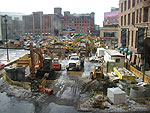By Art Hughes
Minnesota Public Radio
April 8, 2002
Light rail supporters are eager for this fall's scheduled test of Minnesota's first light-rail transit system. They say it represents the culmination of more than three decades of planning and political battles. And if this project is anything like similar light rail systems in other cities, criticism begins to fall off after citizens see it in action. Many other cities have voted to tax themselves in order to expand the original light rail lines. But, if Minnesota's light rail project is similar to others, significant pockets of opposition also linger, threatening to short curcuit development plans related to light rail that determine whether the system succeeds.
| |
|
|
|
||
At Cafe Trieste restaurant in downtown Minneapolis' Lumber Exchange Building, owner Dmitri Soudakov simmers at the construction for the Hiawatha light-rail line outside his window; construction, he says, is driving customers away.
"We still have our customers just because they know we exist here and they like our food. But it doesn't create any new customers because it doesn't look good to walk either both side of 5th Street and see the big machines working there," he says.
Supporters look at this construction with the promise of carting dozens more potential customers past Soudakov's door in a stream of rail cars in less than two years. But Soudakov says he's not sure he'll survive this period of disruption. He questions whether the $675 million project accomplishes anything buses don't.
"It's going to be the same people who take the bus system right now. Personally I won't go downtown, park my car, take a train and go to Mall of America and come back," he says.
Soudakov's concerns echo criticisms the LRT project has drawn since it was first conceived.
Metropolitan Council Chair Ted Mondale says such thinking is the exception, with most public polls showing overwhelming support for light rail transit in Minneapolis. He believes public and political opposition will virtually evaporate once the trains start running.
"Conservative cities like Salt Lake City just passed a $1 billion referendum. Phoenix: a billion-dollar referendum. Denver's on their third line. Portland's on their third. Dallas is on their third. So what happens is once the line's up and running, the politics of this change very quickly. And mark my words: in 2006 the question won't be 'why isn't light rail running in my area' to 'how the heck to I get one of these now?'" says Mondale.
| |
|
|
|
||
City of Minneapolis studies predict the equivalent of about 15 new office buildings the size of the IDS Tower will be built over next 20 years with or without the LRT line. The Met Council foresees the Twin Cities population growing by about a million people over the 30 years.
Supporters see LRT as a locus for development, a place to accomodate the people occupying those downtown spaces without adding more cars to the road.
Sy Adler, a professor of urban studies and planning at Portland State University in Portland, Oregon, says rail transit can't succeed without well-thought-out follow-through by policy makers.
"I do think the viability of transit is keyed very directly to what's happening downtown. And if investment downtown is holding firm, if there's still a lot of retail activity downtown, if the office market is strong downtown, then transit is going to do well," says Adler.
Portland's light rail MAX system, which started in 1986, is often held up as a light-rail success even though ridership has fluctuated over the years. Adler says it's hard to say whether the MAX has eased congestion on Portland area roads. What it has done, he says is provide an appropriate place to focus development.
| |
|
|
|
||
"There's already so much transportation capacity in place throughout the United States that any one additional project is not going to make that much of a difference. Transport investments work well when they are part of a larger package of interventions designed to work in conjunction with the transit investment," according to Adler.
Portland's system does have its critics. A ballot measure goes to voters in May that would strip the regional governing body of its power to guide development density in cities, an indirect challenge to planning related to transit.
Minnesota's opposition comes from those, like Rep. Phil Krinkie, R-Shoreview, who say light rail is a costly service for a handful of people willing to use it.
"A relatively small number of people is going to ride these trains and it's not going to impact the amount of congestion on Highway 494 or 35-W, particularly with the fact that it runs in a relatively moderate corridor," Krinkie says.
Supporters point out the state is set to spend $1 billion on roads this summer alone, more than $300 million more than the construction costs for the Hiawatha light-rail line. Meanwhile, the first sections of tracks are scheduled to be laid in the next few weks.
More from MPR
More Information



